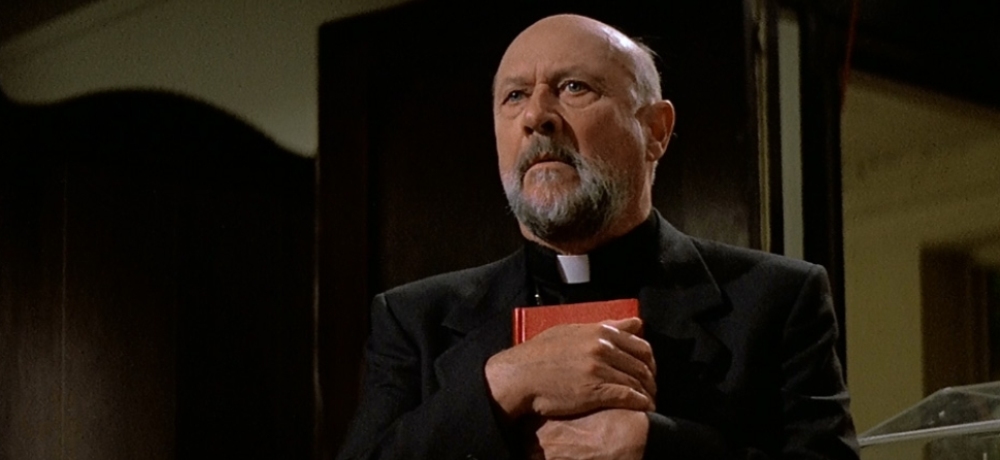


John Carpenter is deservedly known as a master of horror, but he often did not get his just due quick enough. So many of his films did not find a loving audience until after their theatrical releases, including The Thing, Big Trouble in Little China, In the Mouth of Madness, and 1987’s Prince of Darkness, which celebrates its 35th anniversary this year.
The film is the second chapter of Carpenter’s “Apocalypse Trilogy”—which also includes The Thing and In the Mouth of Madness. Although it lacked the star power and larger scope of the other two films, Prince of Darkness still comes off as incredibly rich and complex. It’s a kind of movie you don’t see much of anymore, if at all.
According to Carpenter, Prince of Darkness came at a time when he was tired with the process of making big-budget studio movies. “And I longed to make a low-budget movie where I would have complete control over it—the story, the flow, the characters, the thematic materials,” he recalled in an interview on the movie’s Blu-ray.
But Carpenter also found himself influenced by one of his contemporaries: Italian horror maestro Dario Argento and his 1980 supernatural thriller Inferno. “I loved Inferno, but the thing that was inspiring to me was it was just so free,” Carpenter told Consequence of Sound in an interview. “Narratively, it didn’t make a whole lot of sense, but that didn’t matter. The movie was so profound. I thought, ‘Well, shit, I want to do something like this.’ So that’s what my inspiration really came from.”
The end result was very different from the colorful, dreamlike Inferno, applying science to a supernatural story. Prince of Darkness begins with a priest (Donald Pleasence) investigating the death of an elderly clergyman who leaves behind a key to a basement in a rundown church.
What he finds in the basement is a mysterious green liquid inside a canister surrounded by crucifixes.
The priest ultimately turns to a physics professor (Victor Wong), who enlists a group of students (including Jameson Parker, Lisa Blount, and Dennis Dun) to do testing of the substance on-site. But as the group investigates the liquid and translates old religious texts, they come to a sinister conclusion: the substance in the canister is none other than Satan himself.
From the canister—which we learn can only be conveniently opened from the inside—the Devil is able to control a group of homeless people (including heavy metal god Alice Cooper!), driving them to attack our protagonists and keep them from leaving. The liquid also leaves the canister and begins infecting the students, turning them into zombies that spew the deadly liquid from their mouths. And if things aren’t bad enough, our heroes begin receiving messages from the future in their dreams, warning of the apocalypse that will come if the Devil is allowed to win.
Prince of Darkness feels very much like a Carpenter movie from top to bottom, from his long, wide, and detailed shots to his use of actors to the haunting score, which he co-created with Alan Howarth. The motif of having people do battle in a confined space is also one that he has turned to in projects time and time again, including Ghosts of Mars, his Masters of Horror episode “Pro-Life,” and Assault on Precinct 13, which itself was inspired by Howard Hawks’ western Rio Bravo.
But Carpenter also takes some big swings with the story that seems pretty bold for 1987… and even now. When one of the students (Ann Yen) translates the texts, she uncovers a cover-up by the Roman Catholic Church that hid the fact that the canister was buried by “the father of Satan” in the Middle East, and that Jesus Christ himself was of extraterrestrial ancestry!
He also gives Prince of Darkness what is perhaps his most tragic climax. One of its characters—whose identity I won’t spoil here—ends up having to make the unfair decision of saving the person they love or saving the world. And once that brave decision is made, they suffer a cruel, unjust punishment for it, which gives the viewer a sting that lasts long after the credits have rolled.
Prince of Darkness’ cast is pretty great, too, with Pleasence as the priest who becomes increasingly disillusioned with his faith. A scene where he sits in hiding, begging for help, asking, “Where are you? Christ, where are you?” is probably my favorite piece of acting he ever did. Wong and Dun—reuniting with Carpenter after Big Trouble in Little China—also are enjoyable as teacher and student, while Parker and Blount make very likable romantic leads.
Although Cooper is fun as one of the possessed homeless denizens, the best villainous performance is delivered by Jessie Lawrence Ferguson as a student who gets possessed. He steals scene after scene with his unforgettable, sinister chuckle and a haunting rendition of “Amazing Grace.”
If Prince of Darkness is a Carpenter movie you’ve missed out on, there’s no time like the present to check it out. Besides, you never know when a studio might attempt a belated sequel, an unnecessary remake, or someone may find a mysterious canister of glowing liquid in a basement, threatening the end of the world.
 Daily Dead's Official Podcast!
Daily Dead's Official Podcast! Daily Dead's Official Podcast!
Daily Dead's Official Podcast!